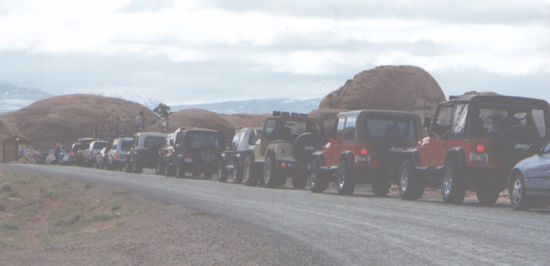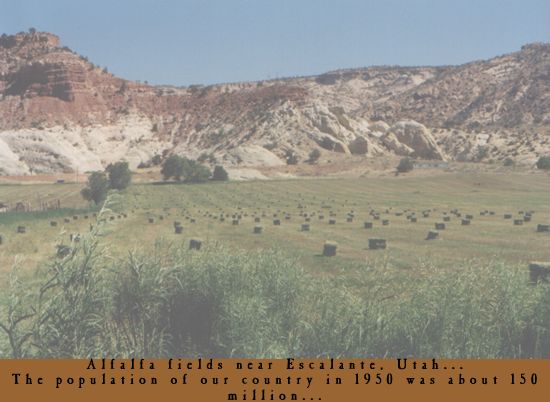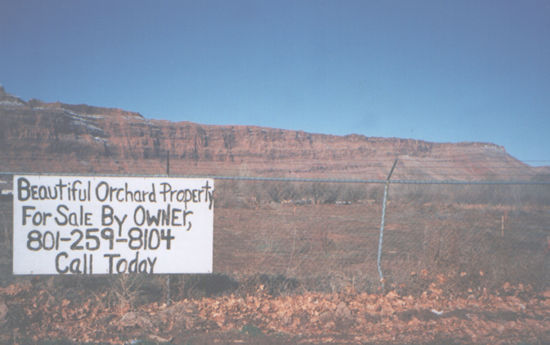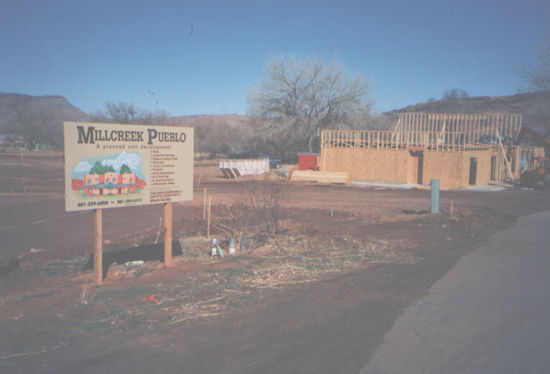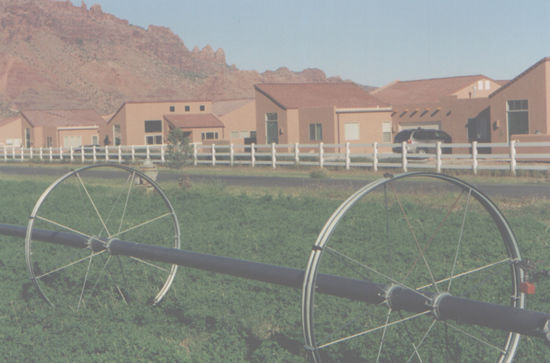

In 1965, the U.S. Department of the Interior published and widely distributed a remarkable glossy, full-color, 80 page booklet called, "The Population Challenge: What it means to America." The periodical (it was the second in a series of "conservation yearbooks" from USDI) was available for one dollar at national parks and monuments across the country and from the government printing office. Stewart Udall, then Secretary of the Interior under President Lyndon Johnson, wrote the forward and much of it is worth quoting.
Udall observed:
"Today we face a grave and subtle conservation challenge--one which may affect our future more vitally than many a sensational subject of the daily banner headlines. The challenge is that of a soaring population, a shrinking allotment of space per person, and the gathering storm of conflict over how to apportion available space, how to stretch natural resources, how to preserve the quality of our environment.
"...Man has been using his power to alter his environment--with a blind pursuit of immediate objectives and a disregard of secondary effects that could endanger the very existence of life on this planet.
"(The National Academy of Science's National Research Council) warns that 'rapid population growth will create difficulties in reaching America's noble goals of optimum education of all, universal abundance, enriched leisure, equal opportunity, quality, beauty, and creativity.'"
Then Udall asked us to assess the quality of our lives and its true meaning...
"Technology holds the key to survival in he years to come, if we are to believe the scientists. But what KIND of survival? Glassed-in, air-conditioned living boxes, with elbow-to-elbow barbecue pits and wall-to-wall frustrations hardly add up to quality, even though the pits are replete with steaks and the armchair table sports a box of chocolate creams.
Our highest aims can be realized only if we face squarely the fact that we must have adequate resources if we are to have a quality existence. But now we must define the word "adequate." We\are beginning to see hat it includes purity of surroundings, an opportunity to stretch, a chance for solitude and quiet reflection.
I believe that Thoreau's decision to "live deliberately"--to absorb the natural world around him, not merely through the senses into his physical being but into his deepest thoughts--to scorn artificiality and find richness in simplicity--is the nutrient of great culture and of a more peaceful world order."
With great insight nd vision, Secretary Udall had clearly stated the challenge that awaited us and I fully expected the next 78 pages to honestly and bravely weigh the crisis ahead and to examine the choices we needed to make as we dealt with this ticking time bomb.
But visionary thought ended with Udall's forward. The rest of the publication failed miserably to deal with over-population, over-consumption. It failed to offer ways to re-discover "richness in simplicity;" instead it offered a list of untapped natural resources that could be exploited and used to meet explosive future water and energy needs. In particular, USDI praised the Bureau of Reclamation's "18 new dams with a total reservoir capacity of 7.4 million acre feet, 8 powerplants with a combined capacity of 1.8 million kilowatts, and 1,200 miles of high-voltage transmission lines."
Udall had railed against the "blind pursuit of immediate objectives" while ignoring those potentially fatal "secondary effects;" yet the recent construction of Glen Canyon Dam was hailed as a great accomplishment that offered cheap hydro-electric energy while conserving water. Technology, it seems, would solve all our problems without any sacrifice.
Nowhere, except in the title of the yearbook series, was the word "conservation" seriously discussed. Udall's comments ultimately seemed frivolous and meaningless. He precisely identified the problem and then allowed the next 10,000 words to refute him.
It wasn't the first time we've paid lip service to the planet's greatest threat. Just last week, Utah transportation planners unveiled their master plan to deal with growth and congestion along the Wasatch Front. The $35 billion plan calls for five new TRAX spurs, two new freeways, including the $451 million Legacy Highway, and one new commuter rail to handle a population in 2030 that is expected to exceed today's numbers by 60% No one in a position of authority--absolutely no one--suggested treating the problem instead of the symptoms. And the symptoms are gruesome.
Here's a sampler of the world today...
On an April morning in Calcutta, India, a 31 year old woman gives birth to her eighth child. By herself, she delivers the baby girl, without assistance from anyone. Weakened by the delivery and already in poor health from the basic living conditions of her life, she knows she cannot provide the care the newborn child needs. She wraps the infant in a sheet, walks unsteadily to the banks of the nearby river, and holds the baby under the water until it is dead. Death seemed a better prospect.
At 125th Street in Harlem in New York City, a group of unemployed, high school dropouts sit idly on the curb and toss pennies into the chalk outline of a recent murder victim. The dead man, a friend of theirs, was stabbed to death that morning in a "drug-related incident." He was 17 years old. Now only the chalk outline remains and the survivors speculate who will be next.
Monday morning on Interstate 15 in Salt Lake City, Utah. Traffic is backed up for miles. The new multi-billion dollar project has only moved the bottlenecks to new locations. Cars and trucks idle for minutes at a time without moving so much as an inch. Drivers' tempers flare as they strain to see some forward motion. Of course, they can't see too far ahead anyway. The yellow-brown cloud of smog that has enveloped the valley for more than two weeks has cut visibility to less than a mile. Some of the older drivers think fondly of their youths, when the Wasatch Mountains shone brightly and clearly above the valley floor.
At Arches National Park, a visitor from Texas...he's been coming here for 30 years...drives his truck to the Fiery Furnace, excited to be among his beloved red rocks again. But the parking lot is full and a new sign says he needs a permit, just to day hike. Undeterred, he heads for his favorite "secret place," an out-of-the-way canyon complex beyond the Great Wall. Instead of the solitude he sought, he finds footprints and bike tracks, the remains of an open fire and two dozen beer cans. And for the first time in three decades, he wonders, where can he go to escape the crowds.
The Unavoidable Fact
Each of these scenarios comes from the same source; yet, we do little if anything to change it. Everything, every social and environmental problem we face on this planet today comes from the irrefutable reality that there are too many of us. And like author Paul Ehrlich asks in his book, The Population Explosion, "why isn't everyone as scared as we are?"
Last year the world's population reached and passed six billion. More than 500 years ago, when Christopher Columbus first wandered West from Europe in search of someone to plunder, about 500 million humans inhabited our planet. It took two centuries for that number to double, to about one billion. By the end of World War II, the world population doubled again.
Werner Fornos of the Population Institute believes that effective birth-control policies and practices could stabilize the world population at 8 billion by the year 2015. That's still 2.25 billion more humans than today. But without such measures, it could increase to as many as 14 billion.
"Some 3 billion young people will be entering their reproductive years in this coming generation," says Fornos. "How well these young people are able to assume the awesome responsibility of parenting...will make the difference between our setting course for an environmental Armageddon in the 21st century or a better quality of life."
Someone once noted that if you put enough rats in a box, they'll eventually eat each other. In the year 2001, we are fast-becoming the rats.
Other facts and figures: Around the world, human overconsumption is drying up the planet's rivers. In China, the Heaven River dried up more than 20 years ago and the famed Yellow River is following suit. In Arizona, the Salt and Gila Rivers once joined west of Phoenix, but agricultural diversion of those waters has left them dry long before their confluence. From the Nile in Egypt to the Colorado in the American West, attempts to control and divert rivers have altered the entire ecology of the region.
Reckless agricultural practices have caused soil losses of 24 to 26 billion tons around the planet each year. We can look for ways to replace our dwindling energy resources, but how do we replace the very soil that grows the crops that feed us?
Human pollution is altering the world's climate in ways we never dreamed possible just a few short years ago. Even skeptics are beginning to take notice. These are global statistics, obvious to most, refuted by some, and ignored by almost everyone. The crisis is so enormous, it overwhelms most of us.
But what about America? When I first oozed into this world, the U.S. population was less than 150 million. In my lifetime, that number has doubled. And yet our population rate pales when placed next to our rate of consumption. Even 60 years ago, at the height f the Depression, Will Rogers said, "America is the first country where its citizens drove to the Poorhouse in an automobile." America has always had more than its fair share of the world's wealth, and that is a subject that warrants more than a mere mention.
But is the United States overpopulated? We hear that the country is approaching Zero Population Growth, but if current immigration and fertility rates continue, the U.S. population, now almost 285 million, will reach 400 million by the year 2050. Yet our leaders claim repeatedly, ad nauseam, that we have the highest standard of living in the world. But by what standard? By our laptop computers and cell phones and Nintendo games and VCRs, DVDs?
Over-population & the Free Market Economy: A Short History
The United States has always been the champion of Capitalism and the Free Market. Many will tell us it's what made our country great. In a growth economy, we must make things. Miners remove iron ore from the ground, the ore is processed at steel mills, the manufactured steel parts become the components of a product, an automobile for instance. Auto workers assemble the parts, truckers ship the finished product to the dealers, the dealers sell the cars to the consumers.
A growth economy requires a population that can provide the necessary work force to produce the product, and a consumer population to buy the product.
The Great Depression of the 1930s is often blamed on the stock market crash of 1929, but it's much more complicated than that. The Crash was merely the effect, not the cause, of America's economic woes. The fact is, U.S. industry kept producing more products than the consumer population could afford to buy. When huge inventories began to build up in warehouses across the country, businesses laid off the workers who made them. Without jobs, they could not pay their bills or make their mortgage payments, so they lost their homes. Without money to buy things, more workers were laid off. Soon factories shut down. The stores that sold the goods that were made in the factories shut down. Meanwhile, banks invested wildly and recklessly with their depositors' savings (there was no FDIC in those days) and as the economy deteriorated, the government under President Hoover refused to intervene. Eventually a quarter of the American work force was unemployed.
If it weren't for Hitler and World War II, it's reasonable to wonder if this country could have ever dug itself out of the economic black hole it was in. But the Second World War did two things.
First, it accelerated the advance of technology and its application in the marketplace by decades. Not only would atomic energy and its consequences have remained far in our future, the extraordinary ability of this country to produce staggering numbers of military armaments and aircraft for the war effort awakened many to the industrial potential of the United States. Winston Churchill, fully aware of that potential, called America the Great Sleeping Giant. The day the U.S. entered the war, he was confident of an eventual Allied victory.
Second, the war put Americans back to work, at jobs that paid reasonably well. But with all materiel going to the war effort, there was little to spend it on. And so Americans saved their pay checks and when World War II ended in 1945, this country had a consumer population the likes of which had never before been seen in human history.
The new technology, re-tooled for civilian uses and a consumer population eager to spend its savings on all that technology, created an unparalleled confidence in the American economy. And that's where I come in.
Part of that confidence manifested itself in the biggest baby-making era in American history. Between 1946 and 1965, WW II veterans and their spouses created 76 million new American children. From 2,858,000 babies born in 1945, the annual birthrate climbed and peaked at 4,308,000 in 1957. And our parents, remembering the austerity of their childhoods, spoiled us rotten. We became the first consumer kiddies generation, demanding every toy and diversion on the market. When we'd consumed all the products that had entertained our parents as children, and were still insatiable for more, the American Free Enterprise System came to our rescue. From hula hoops to frisbees, from Davy Crockett outfits to Silly Putty, whatever Madison Avenue promoted on TV, we wanted.
By 1964, as teenage consumers, we were spending $12 billion annually on...stuff. There wasn't a whole lot of substance to the merchandise we were demanding to buy. But we wanted to buy it just the same. Retail America, of course, was ecstatic. Never before in the history of the country was a generation so driven by the quest for material things, because never before had there been a consumer population so eager to buy and with the means to do it. Consumerism had to be redefined in the context of the 60s, and yet we'd only just begun.
By the late 60s, graduating Boomers started taking their place in the job market. The largest work force in American history was coming of age; we caused it to swell from about 70 million in 1960 to 107 million by 1980. What America faced was the optimum conditions for a massive growth economy...a population to produce the products and a consumer population eager to buy them.
But what were they going to make? Middle class America seemed to have it all by the 1960s. Americans bought their own homes in record numbers. Most houses were heated with natural gas and the old coal furnaces became mementoes of another era. Most households had a new Chevrolet or Ford in the driveway. The centerpiece of any American living room was the TV. Our fathers were extremely proud of their hi-fi sets and zealously guarded them from their children's rock and roll albums.
We had everything we needed to live a happy and healthy life. And from the perspective of 2001, it was a very simple life as well. We just didn't realize how good we had it.
Enter the Growth Economy again. For the economy to grow, it must make things. Well...what did we need? Not much, thanks. We were pretty damn comfortable. So the question became...what do you want?
Damn near everything, it turned out.
And so we began to invent stuff that we never realized we needed until it was invented. Kids no longer had to entertain themselves with their imaginations; they played with their Nintendos and Gameboys.
And we adults are no better. I mean, after all, we're the ones buying all that stuff for the kids. Most Americans have two or three TVs, VCRs, an assortment of kitchen accessories, electronic gadgets...how did I live before I bought my electronic nose hair trimmer? (I don't cast an accusing finger without pointing one at myself; I've found myself just as caught up in all the stuff as the next guy.)
"We are being stripped bare by the curse of plenty."
Winston Churchill
Now what?
So what is the point of all this? It's simply that an expanding and overgrown population has created this materialistic society we now endure and has pushed us farther and farther away from those so-called traditional values that we now remember so fondly and long for so nostalgically. The things that we had to create, manufacture, and sell, if our economy was to grow, were necessary for the burgeoning work force to survive. As for the consumer population, we are now collectively one trillion dollars in debt to the companies and corporations and businesses that have offered us the plethora of things...of stuff, that we now think are indispensable parts of our lives.
Ironically, most social conservatives who lament the loss of "family values" also see an unlimited growth economy as crucial to the vitality of the country. It's just plain wrongheaded, but it continues to be the centerpiece of American politics, and no one in the political arena today has the courage or the insight to realize that never-ending growth will destroy us all.
Our government had expected projections of higher-than-expected growth as a way of reducing our enormous national debt. Yet no one will acknowledge that 100 million more Americans in this country in the last 45 years has put an incredible strain on the nation's infrastructure, its environment, and the well-being of its people. We cannot improve the quality of our lives by a bigger Gross National Product. It's lunacy.
The lunacy manifests itself in every aspect of our lives. From out-of-control crime in our cities and foul and unbreathable air, to the stress and congestion of our highways and the destruction of our remaining wild lands, to the frustrating red tape, confusion, and harassment by our state, local, and federal bureaucracies, it only gets worse.
At a time when corporate America is downsizing its work force to maximize efficiency and increase profit margins (ALWAYS the bottom line!), the vast bureaucracies of the federal, state and local governments are the last work-force bastion of mediocrity in America. I do not mean to suggest that all or even most government employees are giving less than their best to their employers...us. But the government is the last place where workers can claim to be indispensable while contributing very little to the general well-being of the public it serves. Many of government's frustrating rules and regulations exist solely because there are so many bureaucrats who have nothing else to do but write them.
Critics say: Get rid of them! Streamline government! Throw out all those lazy bureaucrats. And do what with them? Private enterprize is firing these days, not hiring.
Closer to Home...
"We are blessed with extraordinary economic prosperity. We can take care of education, meet our needs in the area of human services, spend more money on building highways and cut taxes all at the same time."
Utah Governor Mike Leavitt
With that kind of unrealistic and delusional rhetoric, Governor Leavitt convened Utah's much ballyhooed and media-hyped Growth Summit a few years ago. Utah's population reached 2 million people last year, 16 years earlier than the U.S. Census Bureau expected. In the last decade more than 300,000 acres of open space and farmland in Utah have been devoured by development. By 2018, the state's population is expected to approach 3 million (Grand County's population for the year 2020 is 20,000, up from about 7000 in 1995).
But the Growth Summit concerned itself with the effects of growth without ever addressing the cause of it. The governor and other public officials talked about adding lanes to freeways and introducing light rail to the Wasatch Front and barely paid lip service to preserving Utah's dwindling open spaces through land trusts and government incentives. The latest legislative version would allow the state to provide limited amounts of money to cities and counties who want to protect open space from development. But where would most of the funding come from? And who could afford it?
Locally, consider what used to be a five acre field across from Dave's Corner Market on 400 East in Moab. That land went on the market for $125,000 in 1990. The owner offered the City of Moab first shot at the property, hoping they would maintain the open space as a park. But the Council passed on the offer and a private party grabbed it. Three years later, the same parcel sold for $375,000. Four years ago, the horse pasture became the Mill Creek Pueblos--each pueblo sells for well over $100,000.
How can any land trust, private or public, ever be able to come up with the necessary funding to pay for such projects when the value of the land continues to rise at an almost exponential rate? The answer is: they can't.
It's another simple case of supply and demand. There is a limited amount of land and a lot of people who want to buy it. The market will determine what happens to the land, and with so many people clamoring for it, it's not too difficult to see our remaining open spaces disappear under a layer of asphalt and a rash of new commercial and residential construction in the very near future. The consumer population eventually consumes all.
"The driving force of modern industrial civilization has been individual material gain, which is accepted as legitimate, even praiseworthy on the grounds that private vices yield public benefits. It's long been understood that a society based on this principle will destroy itself. It can persist only with whatever suffering or injustice it entails, as long as it's possible to pretend that the destructive forces that humans create are limited, that the world is an infinite resource, and the world is an infinite garbage can. Either the general population will take control of its destiny...or there will be no destiny to control "
Noam Chomsky
The world's population continues to expand at an extraordinary rate. In developing nations, multi-national corporations look at the masses of poor people and see nothing but unlimited cheap labor to assemble and manufacture products for the consumer population...for us, expending what remains of the earth's dwindling natural resources along the way. And we keep buying, diverting our attention from the crisis that engulfs us. How do we deal with the 'Rats in a Box Syndrome?' Put on the Walkman and turn up the volume...solace through ignorance.
It's still possible to find quiet places in the West. It's still possible to see sunsets of indescribable beauty. I can still immerse myself in the wildness of the land and almost think I was the only human to inhabit it. I can feel a kinship to the animals that makes me think we're not that different.
But we are different; I know their fate rests in my species' hands. We have the knowledge, the technical skills, and even the understanding to do the right thing. What we lack is the will. And without it, we could lose it all.








